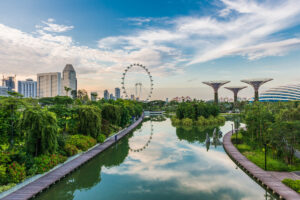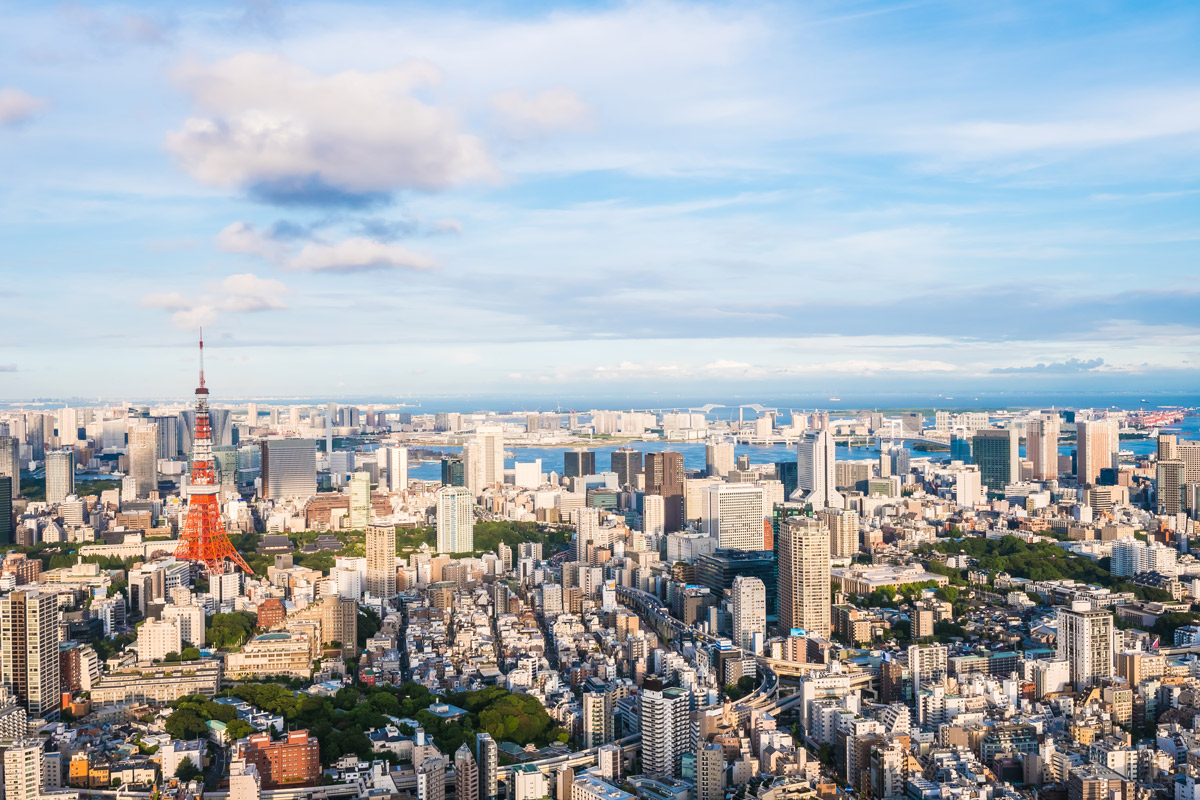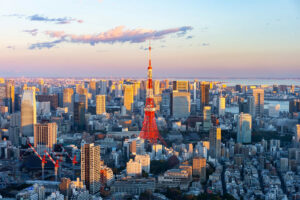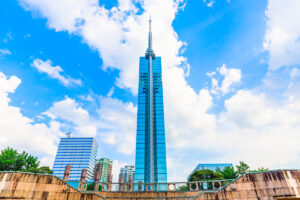Welcome to the heart of Japan’s Kansai region, the timeless city of Kyoto. Known for its rich history, stunning architecture, and vibrant culture, Kyoto is a destination that captivates every traveler’s heart. Whether you’re a history buff, a nature lover, or a foodie, Kyoto has something to offer everyone. In this blog post, we’ll explore the 20 Top-Rated Things to do in Kyoto, a city that effortlessly blends tradition with modernity. Situated in the Kansai region, Kyoto is a stone’s throw away from bustling Osaka and the historic city of Nara, making it a perfect base for exploring this fascinating region. But with so much to see and do within Kyoto itself, you might find it hard to leave!
From the iconic red torii gates of Fushimi Inari Taisha to the tranquil Bamboo Forest, from the historic Nijo Castle to the modern Kyoto Tower, our list covers a diverse range of experiences that encapsulate the spirit of Kyoto. We’ll also delve into the city’s vibrant food scene, its tranquil gardens, and its unique attractions like the Kyoto International Manga Museum and the Kyoto Sky Hop Bus. So, whether you’re planning your first trip to Kyoto or returning to rediscover the city, join us as we embark on this journey through the city’s top-rated attractions. Let’s dive in and explore the wonders of Kyoto together!
1. Kiyomizu Dera
This historic temple offers breathtaking views of Kyoto, especially during cherry blossom season.

Kiyomizu Dera, an iconic symbol of Kyoto, is a must-visit destination for any traveler. This historic temple, perched on the hillside of Higashiyama, offers a unique blend of spiritual serenity and natural beauty. The temple’s name, which translates to “Pure Water Temple,” derives from the Otawa Waterfall running through the grounds. Visitors often partake in the tradition of drinking the waterfall’s sacred waters, believed to bestow health, longevity, and success in studies.
The main hall, a designated national treasure, is a marvel of Japanese architecture. Built without a single nail, it features a large wooden stage that offers breathtaking views of the city and the surrounding forest. This view transforms with the seasons, each offering a distinct charm. However, it’s during the cherry blossom season that Kiyomizu Dera becomes truly magical. The sight of cherry trees in full bloom, framing the cityscape, is an unforgettable spectacle.
Don’t miss the Jishu Shrine located within the temple grounds, dedicated to the deity of love and matchmaking. Walking between the shrine’s two love stones with your eyes closed is said to bring luck in finding love. Whether you’re seeking spiritual insight, historical understanding, or simply the pleasure of beautiful views, Kiyomizu Dera is a destination that encapsulates the heart of Kyoto.
2. Fushimi Inari Taisha
Known for its iconic red torii gates, this Shinto shrine is a must-visit for any Kyoto traveler.
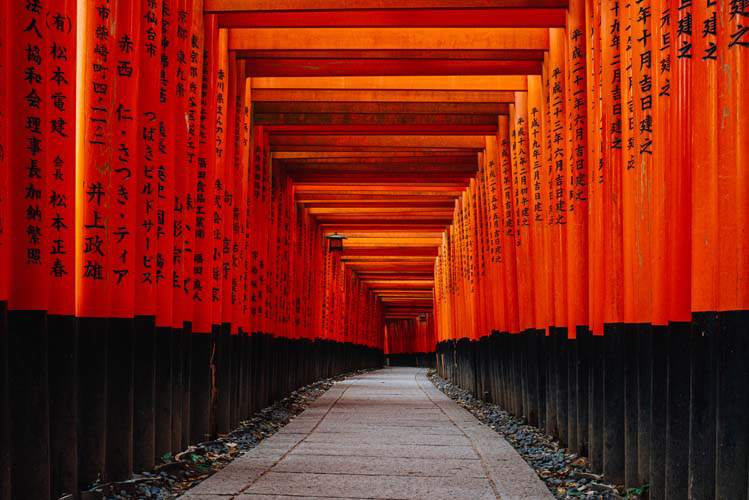
Fushimi Inari Taisha is an essential stop on any Kyoto itinerary. This revered Shinto shrine, nestled at the base of the Inari mountain, is famous worldwide for its thousands of vermilion torii gates that create a mesmerizing pathway up the hillside. The shrine is dedicated to Inari, the Shinto god of rice, sake, and prosperity. Businesses and individuals donate these torii gates to thank Inari for their blessings or to make a wish for future success. As you walk through the seemingly endless arcades of gates, you’ll feel a sense of tranquility and awe.
At the base of the mountain, you’ll find the Romon Gate and the main shrine building, where you can pay your respects. As you ascend, you’ll pass numerous smaller shrines, teahouses, and statues of foxes, considered messengers of Inari.
The hike to the summit and back takes about 2-3 hours, but you can turn back at any point. The higher you go, the fewer people you’ll encounter, and the more peaceful the atmosphere becomes. The view of Kyoto from the Yotsutsuji intersection, halfway up, is particularly stunning. Whether you’re seeking spiritual connection, natural beauty, or a unique cultural experience, Fushimi Inari Taisha offers a memorable journey into the heart of Japanese tradition.
3. Nishiki Market
Dive into the heart of Kyoto’s food scene with a visit to this bustling market.
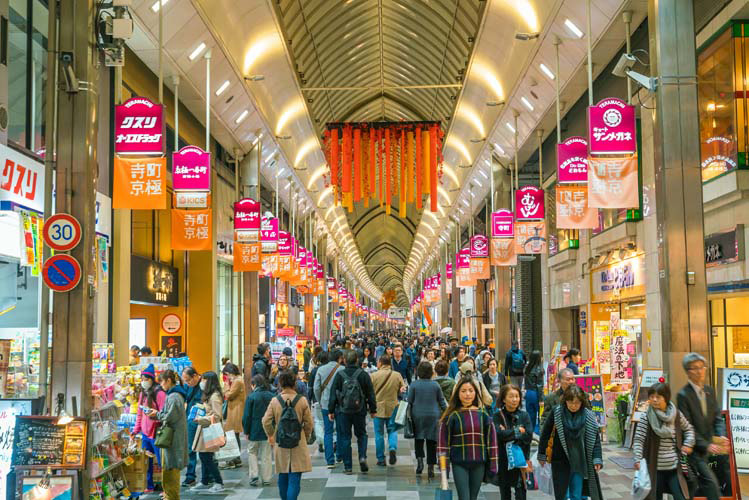
Nishiki Market, often referred to as “Kyoto’s Kitchen,” is a vibrant epicenter of culinary delights. This bustling market street, located in downtown Kyoto, is a must-visit for food lovers and curious travelers alike. Stretching over five blocks, Nishiki Market is home to more than 100 shops and stalls, each offering a unique taste of Kyoto’s rich food culture. From fresh seafood and seasonal fruits to traditional sweets and pickles, the market is a feast for the senses.
One of the market’s highlights is its array of street food. Don’t miss the chance to try local specialties like tako tamago (octopus with quail egg), yuba (tofu skin), and matcha sweets. Many vendors offer samples, allowing you to taste before you buy.
Beyond food, Nishiki Market also sells a variety of Japanese kitchenware, tea, and souvenirs, making it a great place to shop for unique gifts. Visiting Nishiki Market is not just about buying food; it’s an immersive experience that offers a glimpse into the local lifestyle. The market is open every day, but keep in mind that many shops close on Wednesdays. Whether you’re a foodie or a culture enthusiast, a stroll through Nishiki Market is a journey you won’t want to miss when in Kyoto.
4. Nijo Castle
Explore the beautifully preserved rooms and gardens of this 17th-century castle.
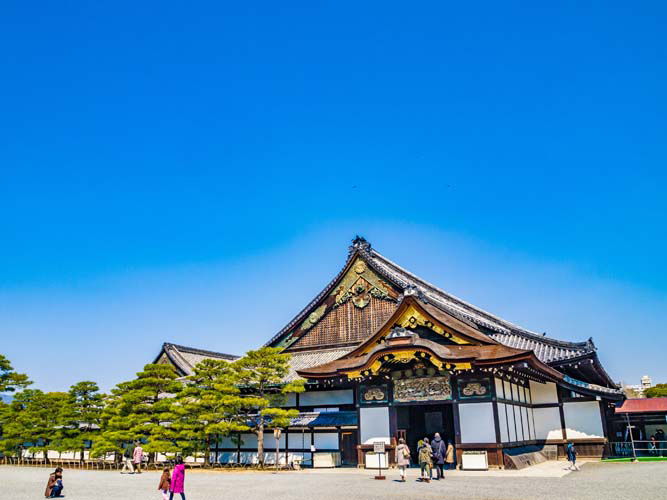
Nijo Castle, a UNESCO World Heritage Site, stands as a magnificent testament to the power and elegance of the Tokugawa shogunate. Built in the 17th century, this historical landmark offers visitors a journey back in time to the era of samurais and shoguns. The castle complex is divided into two main parts: Ninomaru Palace and the Honmaru Palace. The Ninomaru Palace, renowned for its ornate interiors and “nightingale floors” that chirp when walked upon, is the main attraction. The beautifully preserved rooms, adorned with intricate gold leaf designs and elaborate wood carvings, reflect the opulence of the period.
The Honmaru Palace, though less extravagant, is surrounded by stunning gardens. The meticulously manicured landscapes, featuring stone walls, moats, and cherry blossom trees, are a sight to behold, especially during the spring season.
A walk around the castle grounds also reveals several tea houses, where you can experience a traditional Japanese tea ceremony. The Seiryu-en garden, the newest addition to the castle, is a perfect blend of Japanese and Western landscaping styles. Visiting Nijo Castle is not just about exploring historical architecture; it’s about immersing yourself in the rich cultural heritage of Japan. Remember to respect the rules during your visit, such as removing your shoes before entering the palace. This journey into Japan’s past is sure to be a highlight of your Kyoto trip.
5. Bamboo Forest Kyoto
Wander through the serene paths of this famous bamboo grove.

Bamboo Forest Kyoto, also known as Arashiyama Bamboo Grove, is a place of natural wonder and tranquility. This enchanting forest, located in the Arashiyama district of Kyoto, offers a unique experience that should not be missed. As you step into the forest, you’ll be greeted by towering bamboo stalks that seem to touch the sky. The path winds through the grove, creating a mesmerizing tunnel of verdant green. The rustling of the bamboo leaves in the wind and the dappled sunlight filtering through the dense canopy create a serene and almost otherworldly atmosphere.
The Bamboo Forest is beautiful at any time of day, but it’s particularly magical in the early morning or late afternoon when the crowds are smaller. The soft, diffused light during these times casts an ethereal glow on the bamboo, making for stunning photographs.
Adjacent to the forest, you’ll find the Tenryu-ji Temple, a UNESCO World Heritage Site with beautiful gardens. A short walk away is the scenic Togetsukyo Bridge, another popular spot in Arashiyama. Visiting the Bamboo Forest Kyoto is more than just a walk in the park; it’s a step into a tranquil world that feels far removed from the bustling city. Whether you’re a nature lover, a photographer, or a peace seeker, this bamboo grove is a must-visit when in Kyoto.
6. Kyoto Tower
For the best panoramic views of the city, head to the observation deck of Kyoto Tower.
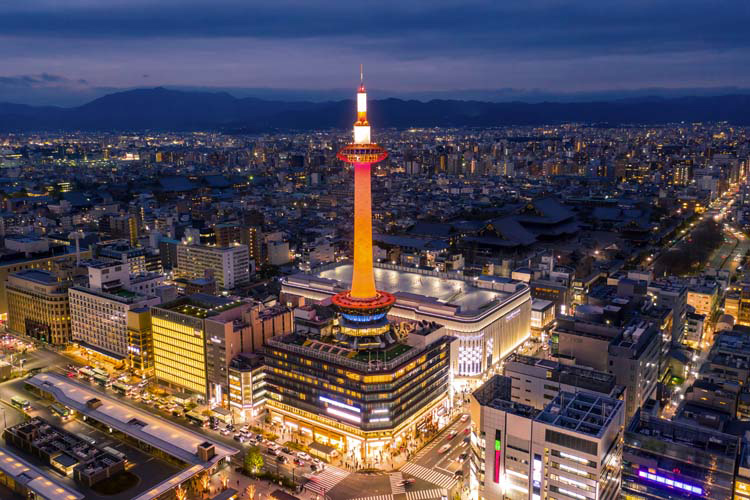
Kyoto Tower, standing tall in the heart of the city, is a beacon of modernity amidst Kyoto’s historical landscape. This 131-meter high tower, the tallest structure in Kyoto, offers an unparalleled view of the city and beyond. The tower’s design, resembling a traditional Japanese candle, is a symbol of the city’s blend of old and new. At the base of the tower, you’ll find a bustling commercial complex with shops, restaurants, and a hotel. But the real highlight is the observation deck, located 100 meters above ground.
From the deck, you can enjoy a 360-degree panoramic view of Kyoto. On a clear day, you can see as far as Osaka. The cityscape, with its mix of modern buildings, ancient temples, and surrounding mountains, is truly breathtaking. The view is equally stunning at night when the city lights up.
For a more immersive experience, use the free telescopes on the deck. The tower also offers audio guides that provide interesting insights about the landmarks you can see from the deck. Whether you’re a first-time visitor wanting to get a lay of the land, or a returning traveler looking for a new perspective, Kyoto Tower is a must-visit. The view from the top is a reminder of Kyoto’s unique charm, where tradition and modernity coexist harmoniously.
7. Kinkakuji
Also known as the Golden Pavilion, this Zen temple is one of Kyoto’s most stunning sights.
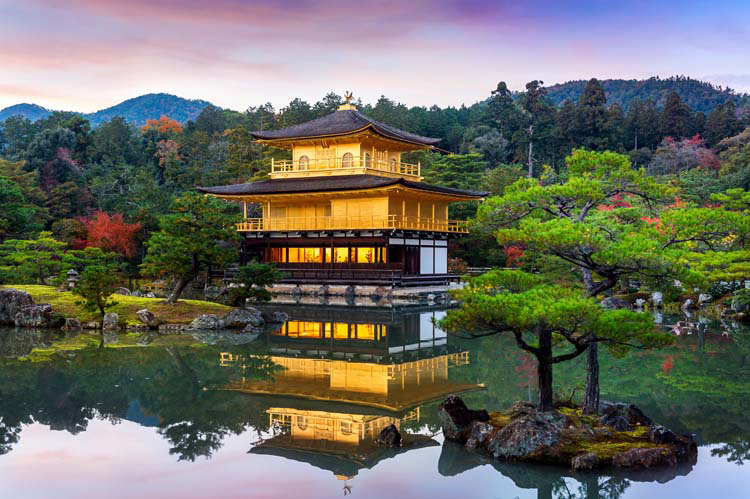
Kinkakuji, or the Golden Pavilion, is a symbol of Kyoto’s enduring beauty and historical significance. This Zen Buddhist temple, officially named Rokuon-ji, is a UNESCO World Heritage Site and one of the most popular tourist destinations in Japan. The temple’s main hall, covered in brilliant gold leaf, is a sight to behold. It shines resplendently against the backdrop of the Mirror Pond, creating a picturesque scene that changes with the seasons. The reflection of the pavilion in the tranquil pond is as stunning as the building itself.
The pavilion is a three-story structure, with each floor representing a different style of architecture. The top two floors, covered in gold leaf, house various Buddhist relics. While visitors cannot enter the pavilion, the view from the outside is more than enough to appreciate its beauty.
The temple grounds also feature a beautiful strolling garden, teahouses, and statues that visitors can explore. The Sekka-tei Tea House is a great place to relax and enjoy matcha tea while taking in the serene surroundings. Visiting Kinkakuji is not just about seeing a beautiful building; it’s about experiencing the harmony of architecture, nature, and spirituality. Whether you’re a history buff, a nature lover, or a spiritual seeker, the Golden Pavilion offers a unique and unforgettable experience.
8. Hanamikoji Street
Experience the charm of Kyoto’s geisha district with a stroll down this picturesque street.
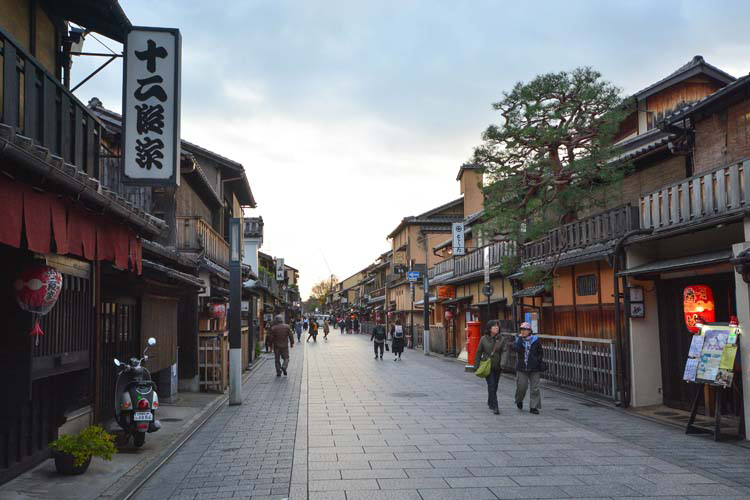
Hanamikoji Street, located in the heart of Kyoto’s Gion district, is a charming avenue that offers a glimpse into the city’s traditional culture. This picturesque street, lined with wooden machiya houses, teahouses, and exclusive restaurants, is the perfect place to experience the allure of Kyoto’s geisha district. As you stroll down the street, you’ll be transported back in time. The well-preserved machiya houses, with their wooden facades and lattice windows, exude an old-world charm. Many of these houses are ochaya (teahouses), where geiko (Kyoto dialect for geisha) and maiko (apprentice geisha) entertain guests with traditional music and dance.
The street is also home to several exclusive restaurants, known as ryotei, serving Kyoto-style kaiseki cuisine. These establishments, often hidden behind unassuming facades, offer a unique dining experience.
One of the highlights of Hanamikoji Street is the chance to spot geiko and maiko on their way to work in the evenings. Their exquisite kimono and distinctive makeup are a captivating sight. Visiting Hanamikoji Street is more than just a walk; it’s a journey into the heart of Kyoto’s cultural heritage. Whether you’re a culture enthusiast, a history buff, or a casual traveler, this charming street offers a memorable experience of Kyoto’s timeless elegance.
9. Arashiyama Monkey Park Iwatayama
Get up close with Japanese macaques in this unique hilltop park.
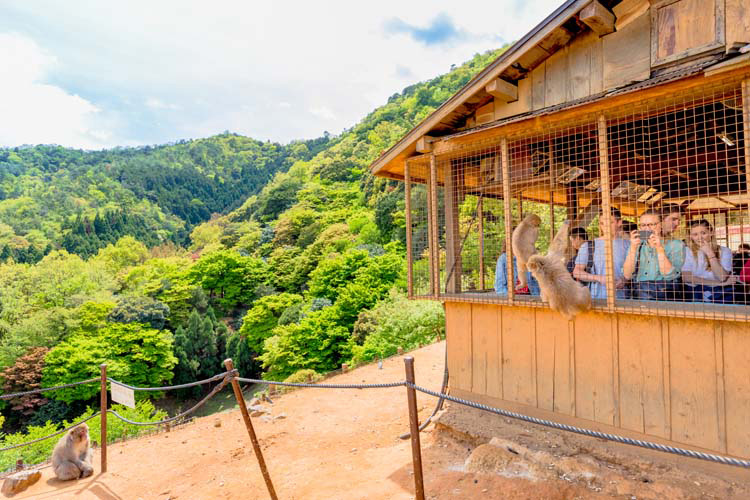
Arashiyama Monkey Park Iwatayama is a unique attraction that offers an unforgettable encounter with wildlife in the heart of Kyoto. Located on the slopes of Mount Arashiyama, this park is home to a troop of over 100 Japanese macaques, also known as snow monkeys. The park offers a rare opportunity to observe these monkeys in their natural habitat. Unlike in a zoo, the monkeys here roam freely, and it’s the visitors who are enclosed in a feeding area. Here, you can purchase apples and peanuts to feed the monkeys under the staff’s supervision.
A short but steep hike up the mountain brings you to the park. The walk is well worth it, not just for the monkeys, but also for the panoramic view of Kyoto from the top. The sight of the city framed by the surrounding mountains and the Hozu River is truly breathtaking.
The park also features informative displays about the monkeys and their behavior, providing an educational aspect to your visit. Remember to follow the park rules, such as not touching the monkeys and not showing them food outside the feeding area. Whether you’re an animal lover or a family with kids, Arashiyama Monkey Park Iwatayama offers a fun and educational experience that adds a touch of adventure to your Kyoto trip.
10. Kyoto National Museum
Discover Japan’s rich history and culture through the museum’s extensive collection.
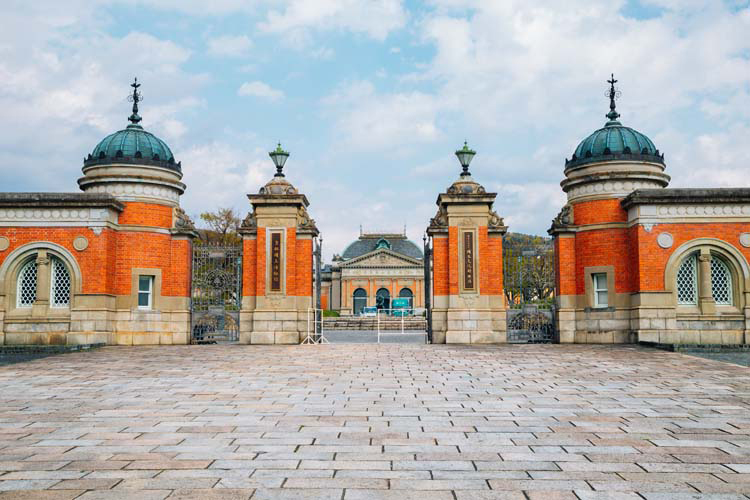
Kyoto National Museum is a treasure trove of Japanese art and history. Located in the city’s Higashiyama district, this prestigious museum is one of the oldest and most respected institutions in Japan. The museum’s collection, comprising over 12,000 items, spans several centuries and covers a wide range of genres. From ancient pottery and Buddhist statues to samurai armor and delicate textiles, each exhibit tells a story about Japan’s rich cultural heritage.
The museum’s main building, the Meiji Kotokan, is an architectural gem in itself. Designed in the French Renaissance style, it stands as a symbol of the cultural exchange between Japan and the West during the Meiji era. The museum also hosts special exhibitions throughout the year, showcasing works from other museums and private collections. These exhibitions offer a deeper insight into specific aspects of Japanese art and culture.
A visit to the Kyoto National Museum is not just about viewing artifacts; it’s about immersing yourself in the narratives of Japan’s past. The museum offers English information and audio guides, making it accessible to international visitors. Whether you’re a history buff, an art enthusiast, or a curious traveler, the Kyoto National Museum offers a fascinating journey through Japan’s cultural history that will enrich your Kyoto experience.
11. Kyoto Railway Museum
Train enthusiasts will love exploring Japan’s railway history here.
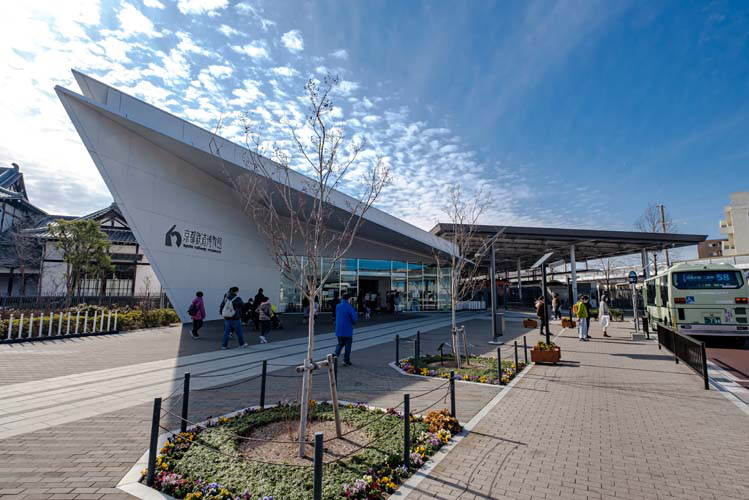
Kyoto Railway Museum is a paradise for train enthusiasts and a fascinating destination for all visitors. This state-of-the-art museum, located near Kyoto Station, offers an in-depth look into Japan’s railway history and technology. The museum houses an impressive collection of over 50 real-size train exhibits, ranging from steam locomotives to modern shinkansen (bullet trains). Each train is meticulously preserved, allowing visitors to explore the interiors and understand the evolution of train technology.
One of the museum’s highlights is the roundhouse, a circular building with a turntable in the center, housing several vintage steam locomotives. The building itself is a designated Important Cultural Property of Japan. Interactive exhibits, such as train driving simulators and a mini train ride, add a fun element to your visit. The museum also features a comprehensive display on railway infrastructure, including signals, tracks, and bridges.
The museum’s observation deck offers a panoramic view of Kyoto Station and the shinkansen tracks, a perfect spot for train spotting. A visit to the Kyoto Railway Museum is not just about trains; it’s about appreciating the role of railways in Japan’s development and experiencing the passion for trains that is deeply ingrained in Japanese culture. Whether you’re a train enthusiast or a family with kids, this museum promises an enjoyable and educational experience.
12. Kyoto Aquarium
A great spot for families, this modern aquarium houses a variety of marine life.
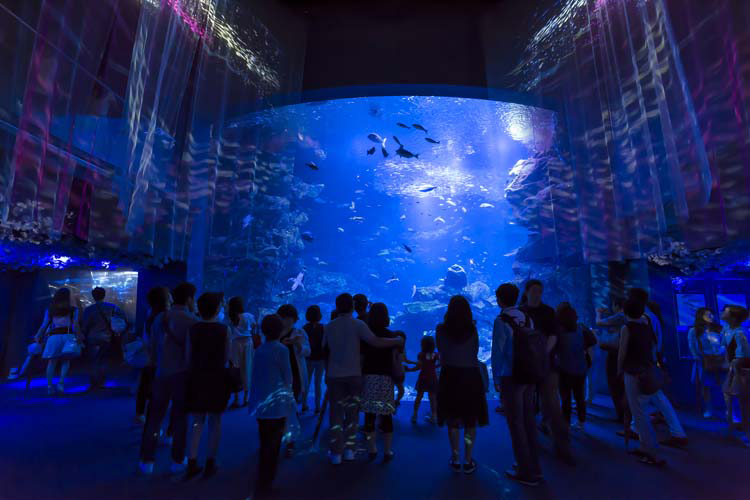
Kyoto Aquarium is a world-class facility that offers an exciting and educational journey into the underwater world. Located in Umekoji Park, this modern aquarium is a perfect destination for families and marine life enthusiasts. The aquarium houses a diverse range of marine and freshwater species, meticulously displayed in environments that mimic their natural habitats. From the vibrant coral reefs teeming with tropical fish to the mesmerizing jellyfish exhibit, each section offers a unique glimpse into the aquatic world.
One of the aquarium’s highlights is the large tank representing the Sea of Japan. Here, you can observe a variety of sea creatures, including sharks, rays, and schools of fish, coexisting in a dynamic ecosystem. The aquarium also features a popular dolphin show, where visitors can watch these intelligent creatures perform impressive tricks and learn about their behaviors. The interactive touch pool, where you can touch starfish and sea cucumbers, is a hit with children.
Kyoto Aquarium is not just about observing marine life; it’s about promoting understanding and conservation of our oceans. The aquarium offers informative displays and educational programs, making your visit both fun and enlightening. Whether you’re a marine life enthusiast or looking for a fun family outing, Kyoto Aquarium offers a fascinating and enjoyable experience that will deepen your appreciation for the aquatic world.
13. Kyoto Botanical Gardens
Enjoy the tranquility of these expansive gardens, home to thousands of plant species.
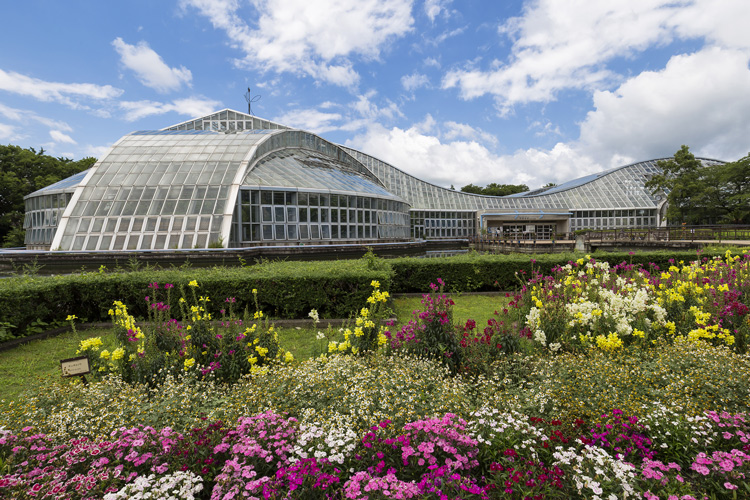
Kyoto Botanical Gardens is a haven of tranquility and natural beauty in the heart of the city. Established in 1924, these expansive gardens are the oldest and most comprehensive public botanical gardens in Japan. Spread over 240,000 square meters, the gardens are home to around 12,000 species of plants. The collection is meticulously organized into different sections, including a rose garden, a bamboo grove, a Japanese native plant garden, and a conservatory housing tropical and subtropical plants.
One of the garden’s highlights is the cherry blossom trees that bloom spectacularly in spring. The autumn foliage, particularly in the maple tree forest, is equally breathtaking. The gardens also feature a European-style arboretum, a bonsai exhibit, and a peaceful pond surrounded by seasonal flowers. The Nakaragi-no-mori Forest, located in the garden’s northern part, offers a glimpse into the natural landscape of the Kyoto basin.
A visit to the Kyoto Botanical Gardens is not just about admiring plants; it’s about immersing yourself in the calming influence of nature. The gardens offer a respite from the bustling city and a chance to appreciate the diversity and beauty of the plant kingdom. Whether you’re a nature lover, a gardening enthusiast, or a traveler seeking a peaceful retreat, the Kyoto Botanical Gardens offer a delightful and rejuvenating experience.
14. Funaya
Experience traditional Japanese living in these unique boat houses.
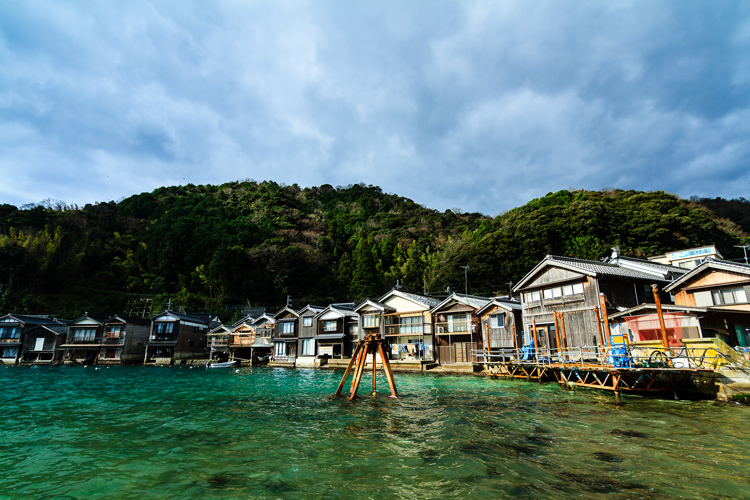
Funaya, or boat houses, offer a unique glimpse into traditional Japanese living. These distinctive dwellings, primarily found in the fishing village of Ine in Kyoto Prefecture, are a charming blend of functionality and tradition. A funaya is a two-story structure built on the water’s edge. The lower level serves as a garage for boats, reflecting the village’s fishing heritage, while the upper level is a living space. These houses are built with traditional Japanese architectural techniques, featuring tatami rooms and sliding doors.
A stroll through the village offers picturesque views of rows of funaya along the bay. The sight of these houses, with their wooden facades and thatched roofs, against the backdrop of the serene bay, is truly enchanting.
Some funaya have been converted into guesthouses, offering visitors a unique opportunity to experience traditional Japanese lifestyle. Staying in a funaya, you can wake up to the sound of waves, enjoy fresh seafood, and explore the bay in a fishing boat. Visiting Funaya is not just about seeing unique houses; it’s about immersing yourself in a traditional way of life that has been preserved for centuries. Whether you’re a culture enthusiast or a traveler seeking unique experiences, a visit to the funaya of Ine offers a memorable journey into Japan’s cultural heritage.
15. Fukuchiyama Castle
This reconstructed castle offers a glimpse into Japan’s feudal past.
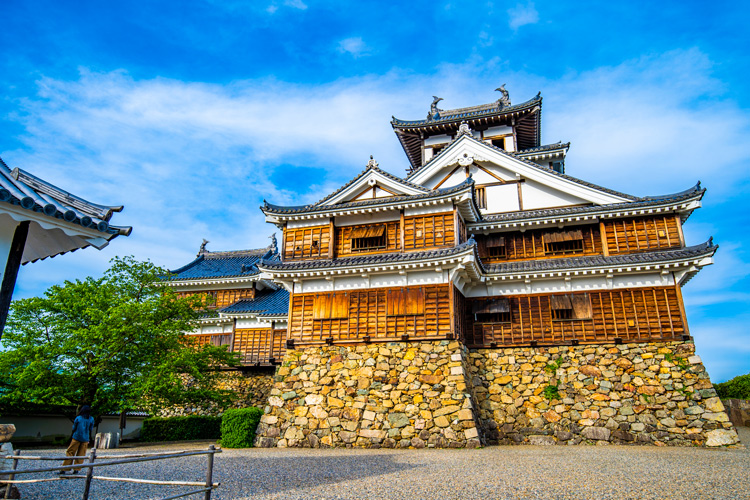
Fukuchiyama Castle, located in the northern part of Kyoto Prefecture, is a captivating destination that transports visitors back to Japan’s feudal era. This reconstructed castle, perched atop a hill, is a symbol of the city’s rich history. Originally built in the 16th century by a samurai warlord, the castle was an important stronghold during the Warring States period. The current structure is a faithful reconstruction, offering a glimpse into the architectural style and defensive features of traditional Japanese castles.
The castle’s three-story keep houses a museum showcasing artifacts from the feudal era, including samurai armor, weapons, and historical documents. The top floor offers a panoramic view of the city and the surrounding countryside, a sight that is particularly stunning during the cherry blossom season.
The castle grounds feature beautifully landscaped gardens, stone walls, and a moat, adding to the historical ambiance. The castle park, home to over 1,000 cherry trees, is a popular spot for hanami (cherry blossom viewing) in spring. Visiting Fukuchiyama Castle is not just about exploring a historical building; it’s about stepping back in time and immersing yourself in Japan’s feudal past. Whether you’re a history buff or a curious traveler, this castle offers a fascinating and enriching experience.
16. Amanohashidate
Known as one of Japan’s three most scenic views, this sandbar is worth the trip.
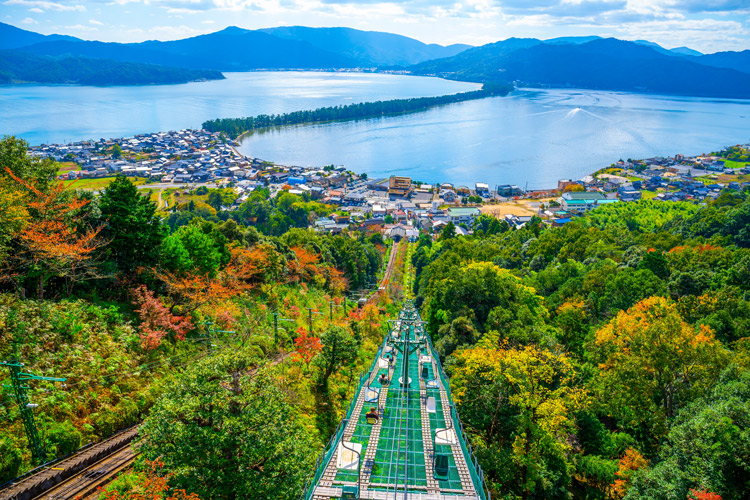
Amanohashidate, located in the northern part of Kyoto Prefecture, is a natural wonder that captivates visitors with its serene beauty. Known as one of Japan’s three most scenic views, this picturesque sandbar is a must-visit destination. Stretching nearly 3.6 kilometers across Miyazu Bay, Amanohashidate is a narrow strip of land covered in thousands of pine trees. The name, which translates to “bridge in heaven,” comes from the stunning view of the sandbar against the blue waters, resembling a pathway connecting the heavens and the earth.
There are two viewpoints, each on opposite sides of the bay, offering panoramic views of the sandbar and the surrounding landscape. The traditional way to enjoy the view is through a unique practice called “matanozoki,” where you view the sandbar upside down through your legs, making it appear like a bridge in the sky.
You can also explore the sandbar on foot, by bicycle, or by a boat ride in the bay. Along the way, you’ll find shrines, temples, and beaches, adding to the area’s charm. Visiting Amanohashidate is not just about seeing a beautiful view; it’s about immersing yourself in the tranquility and natural beauty of the landscape. Whether you’re a nature lover or a traveler seeking unique experiences, Amanohashidate offers a memorable escape from the hustle and bustle of city life.
17. Kyoto International Manga Museum
Dive into the world of manga at this comprehensive museum.

Kyoto International Manga Museum is a paradise for manga enthusiasts and a fascinating destination for all visitors. Located in the heart of Kyoto, this museum is dedicated to the art of manga, showcasing its history, diversity, and cultural significance. The museum houses an extensive collection of over 300,000 items, making it one of the largest manga collections in the world. The collection spans from post-war manga to contemporary works, including international manga. The museum’s walls are lined with bookshelves, creating a “Manga Wall” that visitors can browse and read at their leisure.
The museum also features several exhibitions, workshops, and live drawing demonstrations by professional manga artists. These interactive experiences provide insights into the creative process behind manga and its impact on popular culture.
One of the museum’s highlights is the Manga Studio, where visitors can try their hand at drawing manga under the guidance of professional artists. The museum also has a section dedicated to kamishibai, a form of Japanese street theater and storytelling that predates manga. Visiting the Kyoto International Manga Museum is not just about reading manga; it’s about immersing yourself in the world of manga and appreciating it as a form of art and storytelling. Whether you’re a manga fan or a curious traveler, this museum offers a unique and enjoyable experience.
18. Kyoto Sky Hop Bus
See the city’s top sights from the comfort of this hop-on, hop-off bus.
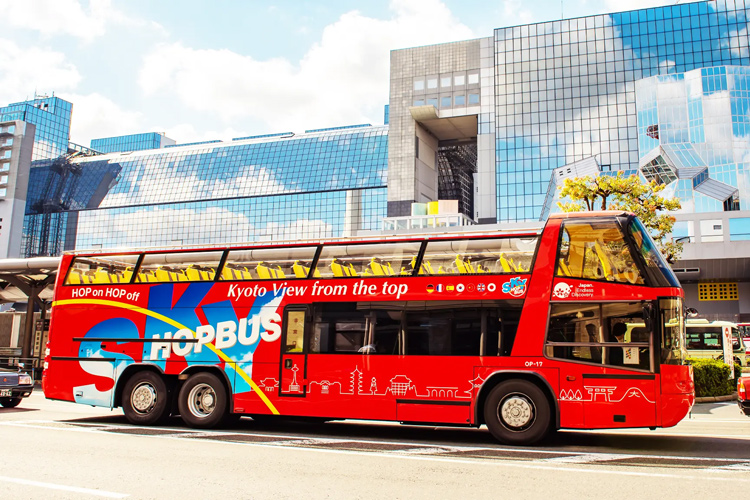
Kyoto Sky Hop Bus is a convenient and enjoyable way to explore the city’s top sights. This hop-on, hop-off bus service offers a flexible and comfortable way to navigate Kyoto, making it a great option for first-time visitors. The bus follows a route that covers major attractions, including Kinkakuji (Golden Pavilion), Kiyomizudera Temple, and Nijo Castle. The open-top double-decker bus offers panoramic views of the city, allowing you to take in the sights and sounds of Kyoto from a unique perspective.
One of the key advantages of the Sky Hop Bus is the flexibility it offers. With your ticket, you can hop on and off at any stop, allowing you to explore the sights at your own pace. The buses run at regular intervals, so you can plan your day without worrying about transportation.
The bus also provides an audio guide service in multiple languages, offering interesting facts and stories about the sights along the route. Whether you’re a solo traveler, a family, or a group, the Kyoto Sky Hop Bus offers a convenient and enjoyable way to explore the city. With the freedom to hop on and off as you please, you can create your own personalized Kyoto sightseeing adventure.
19. Fukuda Art Museum
Art lovers should not miss this museum’s collection of Japanese and East Asian art.
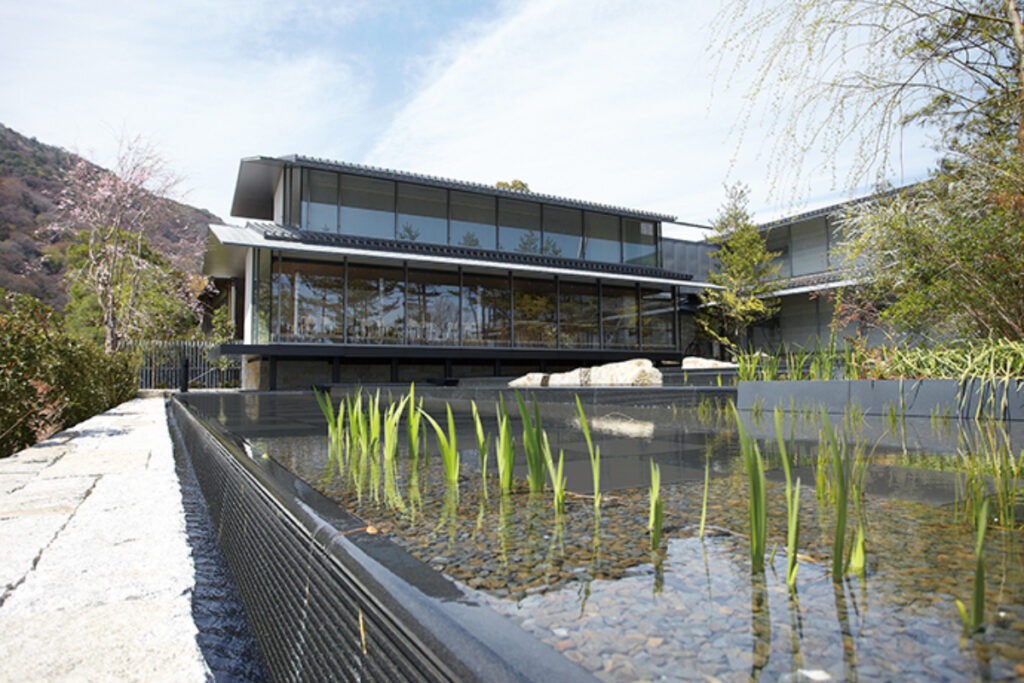
Fukuda Art Museum is a gem for art lovers, nestled in the heart of Kyoto. This private museum showcases an exquisite collection of Japanese and East Asian art, offering visitors a serene and enriching experience. The museum’s collection, carefully curated by the Fukuda family over generations, includes over 1,000 items. The exhibits range from ancient pottery and Buddhist statues to ink paintings and calligraphy, reflecting the diverse artistic traditions of the region.
One of the museum’s highlights is its collection of tea ceremony utensils, showcasing the deep connection between art and the tea ceremony in Japanese culture. The museum also features rotating exhibitions, offering fresh perspectives on its collection.
The museum building itself is a work of art. Designed by renowned architect Tadao Ando, the museum blends modern architecture with traditional Japanese aesthetics. The tranquil garden, featuring a pond and seasonal flowers, adds to the museum’s serene ambiance. Visiting the Fukuda Art Museum is not just about viewing art; it’s about immersing yourself in the beauty and tranquility of East Asian art and culture. Whether you’re an art enthusiast or a curious traveler, this museum offers a peaceful retreat and a feast for the eyes.
20. Fushimi Momoyama Castle
Visit the stunning grounds of this hilltop castle, known for its cherry blossom trees.
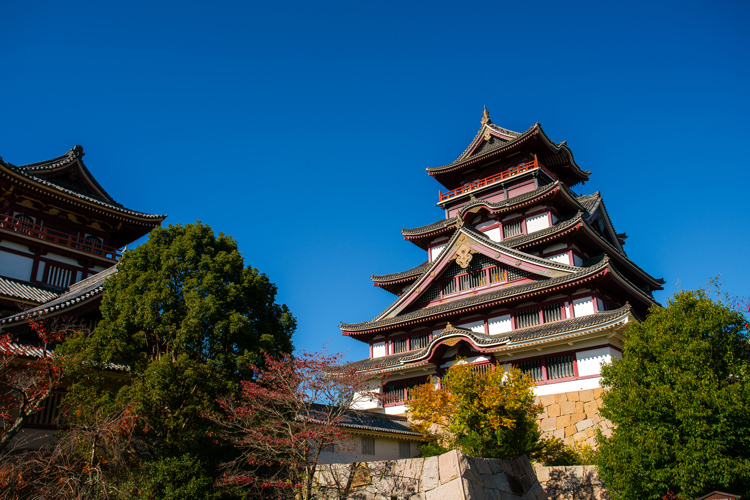
Fushimi Momoyama Castle, located in Kyoto’s Fushimi Ward, is a captivating destination that combines historical intrigue with natural beauty. This hilltop castle, known for its stunning cherry blossom trees, offers a unique glimpse into Japan’s feudal past. The castle we see today is a reconstruction of the original 16th-century castle, faithfully replicating its architectural style. The castle’s main keep, with its white walls and elegant roof, stands majestically against the backdrop of the surrounding city.
The castle grounds are a sight to behold, particularly during the cherry blossom season. The castle is surrounded by over 1,000 cherry trees, creating a spectacular display of pink blossoms in spring. The sight of the castle, framed by the blooming cherry trees, is truly enchanting.
The castle grounds also feature a Japanese garden, complete with a pond and traditional tea houses. The garden is a peaceful retreat, offering a respite from the bustling city. Visiting Fushimi Momoyama Castle is not just about exploring a historical site; it’s about experiencing the beauty and tranquility of a traditional Japanese landscape. Whether you’re a history buff, a nature lover, or a traveler seeking unique experiences, Fushimi Momoyama Castle offers a memorable journey into Japan’s cultural heritage.


